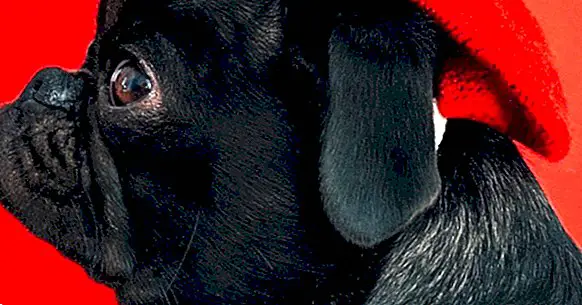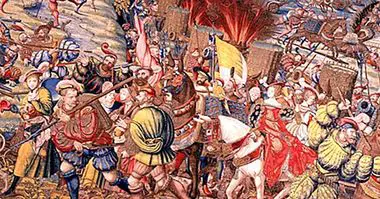What does the color red mean in Psychology?
Red is the blood that runs through our veins, like red orange the color of the flames. The color red is one of the most outstanding and quickly perceived in nature, distinguishing quickly and not being as frequent to observe as green or blue.
But he has always enclosed a deep symbolism, perhaps the most visceral of all the colors that exist. Beyond the symbolic, red also has a psychological meaning and can modulate our behavior. What does the color red mean according to psychology? Let's see it throughout this article.
- Related article: "Psychology of color: meaning and curiosities of colors"
The color red: what is it?
Before starting to talk about what the red color symbolizes and means at a psychological level, it should be mentioned that color is not something intrinsic to objects or things but is the result of the act of perceiving. That is, we see red things because our eye captures certain wavelengths of light through a certain type of cones in our eye that our brain later interprets as that color.
In the specific case of red, the corresponding wavelengths are those between 654 nm and 700 nm , actually understanding within the consideration of red a large number of shades depending on their level of mixing with other colors. It is one of the three primary colors, whose meaning at the psychological level is influenced by its association with perceived stimuli of said color or some of its mixtures with other colors, especially with orange.
Symbolism and meaning of the red color at the psychological level
As we said in the introduction the red color is one of the most symbolism usually has psychological and even religious level, because a series of concrete elements are perceived of that color. Specifically, the strongest associations of the red color are with fire (although curiously the most common type of fire usually has an orange color) and with blood. By extension, it is also linked to heat, the Sun, war and violence (in which blood is common).
It is a color that like in the rest of cases reflects both positive and negative aspects , although together with the black and unlike the other colors is often frowned upon due to the relationship with violence.
From the psychology of colors, which studies the psychic effects of color derived mainly from the social and cultural perception of these (the symbolism) and its effect on the brain, we can highlight the following associations in the case of the color red.
Among the most positive, red is associated with heat, passion and energy. It is also linked to affectivity, being in its positive pole also associated with love (although one of its derivatives, the rose), sensuality and sex tend to have a greater connection. It has also been associated with prosperity and power , as well as to force. Also to vitality and dynamism, to good health, to happiness and even to extraversion.
It is also common to relate to spontaneity and daring. In fact, psychologically it has been observed that this color slightly stimulates a more extroverted behavior. It has also been observed that it is an activating color for the human being and that it helps to generate movement and act to achieve one's goals. It is also related to success, independence and autonomy and even to life.
But their negative connotations, linked to blood, are probably much more known. In this sense, red has been linked throughout history with violent behavior, hatred, aggression, lack of control, emotional lability , the excess and danger. Also with competitiveness (although this connotation can be good or bad depending on whether or not it takes the extreme). Sometimes it is linked to destruction, cruelty and death. It has been observed that the color red is also linked to behaviors that are not very reflective and tend to ignore risk. In fact, there is an urban legend that people with a car of that color often have to pay more in insurance due to this association.
In short, this is one of the colors in which the bipolarity of the symbolism of colors is most clearly seen, associating both aspects as valued as love up to the concepts considered totally contrary, such as hatred in this case. It is the color of intensity and the visceral, associated with a powerful and extreme emotionality and contributing in fact to generate an intense emotional response.
Use of this color in different fields
All of the above aspects are not merely anecdotal or aesthetic, affecting and taking into account in practice in very diverse areas. For example, the color red is not usual in health centers beyond its symbol, because of its relationship to blood and pain . It is also usually avoided in places where silence and reflection are required, such as libraries. It is also not recommended in people who are already very excitable in themselves. since they can be overexcited.
However, it is usual that it is used to paint houses where you want to generate dynamism and activity. In clothing is usual in order to express closeness, activity or strength, although on the other hand it can also be counterproductive if we are in situations such as job interviews as it is linked to lack of control, little commitment and little capacity for reflection. Also, it is usual in the case of females to be used in dresses or lipsticks as an element of distinction and sensuality .
In the world of marketing, its link with power and activity often makes different brands use it with products. It has also been seen that stimulates action, thoughtless behavior and consumerism, being used to improve the likelihood of purchase. It is also often used in products intended for a young and vital public. It has also been observed that it is a color that tends to stimulate hunger and ingestion, with what is usual in food brands. Finally, it is usually employed to signal danger due to its high brightness , usually mixed with black or yellow.
And in other cultures and times?
We have seen the meaning attributed to the color red at a general level, but the truth is that in different regions of the world the symbolism of that color can vary in different measure.
For example, in China it is seen as a color of good luck and long life , its use being usual in celebrations to attract them. In India it is also associated with marriage, fertility, purity and power. It is usually used in weddings, being a color associated with the robes of the goddess Lakshmi (goddess of good luck, beauty and wealth). In South Africa it is used as the color of mourning.
Historically in cultures and societies that have always lived in conditions of intense cold the red color is mostly a symbol of positivity and life, due to its connection with the heat . Among them we can highlight Russia.
On the other hand, in cultures where heat is a cause of suffering or even death, it can be seen as a negative symbol. Specifically, in ancient Egypt it was considered that red was the symbol of evil and destruction, although it could also symbolize life and regeneration.
In the Europe of the Middle Ages it had double reading; on the one hand the red one was related with evil and guilt (being many redheaded women accused of being witches and burned at the stake), while on the other the color of the blood symbolized Jesus Christ and the idea of sacrifice and redemption. In fact, for that reason the clothes of the Pope were red and at present the cardinals wear that color. It was also ended by associating with the feminine, an association that is still valid today.



















